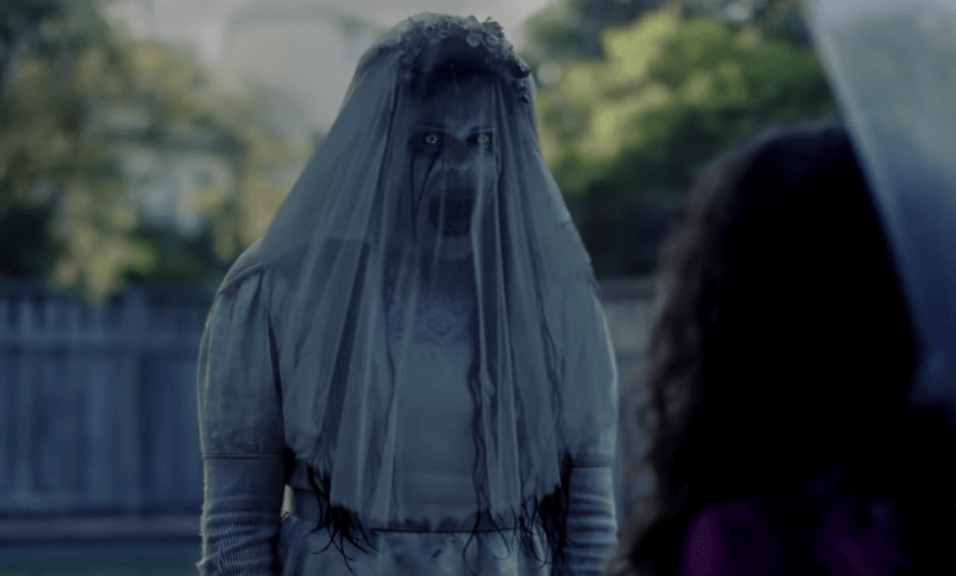Since the days of the conquistadores, the mythology of La Llorona, which means "Weeping Woman" in Spanish, has been a part of Hispanic culture throughout Southwest America and Mexico. According to one of Mexico's most renowned oral traditions, the tall, slender spirit is supposed to be gifted with natural beauty and long flowing black hair. She wanders the rivers and creeks in a white robe, crying into the night and looking for children to take to a watery grave, and now spends her eternity searching for them in rivers and lakes.
=
According to legend, La Llorona, also known as "Maria," was born into a peasant family in a small village. Her stunning beauty drew the attention of all the local males. Despite spending her days in her lowly peasant surroundings, she would dress up in her best white gown in the evenings to entertain the men who admired her at the local fandango. Every male was looking forward to her arrival, and she relished the attention. However, the young mother had two tiny boys, whom she frequently left alone while having fun with the males in the evenings. The two little boys were discovered drowning in the river one day. Some claim they drowned due to her carelessness, while others claim they perished at her hands
The narrative differs slightly depending on who recounts it, but the basic premise remains the same. According to folklore, a young woman named Maria resided in a remote area known as a rural settlement. She hailed from a poor background, yet her beauty was well-known in her neighborhood. One day, a wealthy nobleman passed through her hamlet and halted when he noticed Maria, who he immediately enchanted. The man who showered her with gifts and attention was smitten by her attractiveness, so she accepted his proposal right away.
=
He began to shift following the birth of their two kids, reverting to a life of womanizing and booze, frequently abandoning her. He appeared to have lost interest in Maria, and he told her that he planned to marry a woman of his social class. He was often on the move, and when he did return home, it was mostly to see his kids, which made Maria hate them. Her husband arrived in a carriage with a beautiful lady alongside him while strolling with her two children on a quiet route near the river one evening. He just came to a halt to meet his children, completely disregarding Maria, before driving the carriage along the road without looking back.
Maria, enraged and betrayed, drove her children to a river and drowned them. She realized what she had done as they disappeared downstream and ran down the bank to save them, but it was too late, for the river had already swept them away. Maria broke down in tears and ran, shouting and weeping through the streets, frantic.
The lady wept day and night, refusing to eat, and instead of walking down the river in her white robe, seeking her boys in the hopes that they would return to her. She sobbed nonstop, and as she walked down the riverbanks, her clothes grew filthy and tattered, and she refused to eat, resulting in her becoming a walking skeleton. She died on the same riverbank where she had murdered her children.
=
Her restless ghost began to visit the region shortly after her death, strolling the banks of the Santa Fe River as darkness set. People began to be scared of going out after dark because of her sobbing and wailing. The deceased children and a crying mother, either human or spirit, are constants throughout the folklore. She was claimed to have been seen floating on the current or drifting between the trees along the beach with her long white robe spread out onto the waves, and many a night, people would see her pacing along the riverside, wailing for her children. As a result, she became known as La Llorona, the crying woman, rather than Maria. You should go the other direction if you hear her weeping since her screams might bring you bad luck or perhaps death. Many parents tell their children this story to keep them from staying up too late, and youngsters are advised not to walk out in the dark because La Llorona may murder them and hurl them into the rushing waters. She is said to weep "Ay, mis hijos!" which translates to "Oh, my children!" or "Oh, my boys!" and it is said that she sweep the bottom of rivers and lakes looking for her kids.
Though versions differ, it is stated that she acted without hesitation or pity, and the stories of her cruelty vary depending on whatever version of the legend you hear. Some claim she murders indiscriminately, capturing men, women, and children who dare to approach her. Others claim she murders youngsters exclusively, dragging them screaming to their deaths in a pond. The ghost has been observed several times at the PERA Building (Public Employees Retirement Association) in Santa Fe, New Mexico, which was erected on an old Spanish-Indian burial near the Santa Fe River. Many of the employees have heard cries echoing through the corridors and have felt invisible hands forcing them down the stairwells.
La Llorona's wanderings have evolved to include following Hispanic people wherever they go since many have heard her wailing beside rivers late at night. Her footsteps have been observed across the Southwest and as far north as Montana's Yellowstone River. Hispanics believe she will always be with them, looking for her children in the many rivers. As a result, many of them are terrified of the dark and pass on the custom to their children.
Written by Joshua Marasigan, New Age Hub



























No comments:
Post a Comment